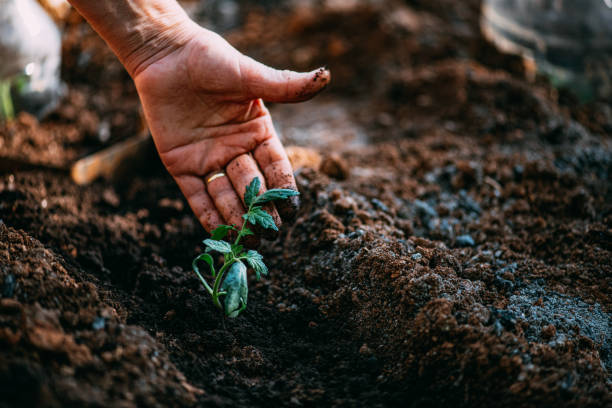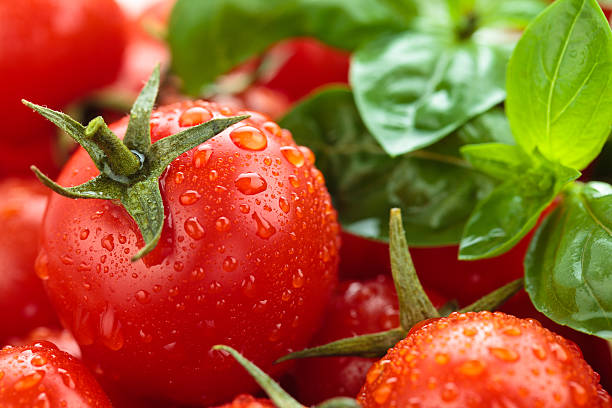
Knowing how often to water tomato plants is simple but not always easy to determine. There are some factors you’ll need to consider before dousing your plants with water.
How often should you water tomato plants?
The easiest way to determine and create a watering schedule for your tomato plants is to do the following:
- Water the soil of your tomato plants.
- Check daily to see if the topmost inch is still moist.
- If the top layer is dry, check the soil underneath it.
- If it is wet, leave it alone.
- If it is dry, water the soil
- Look back at how many days have passed before you have last watered the soil.
- The amount of time will be your watering frequency for that particular season.
Note that during winter, it is best to water your tomato plants once a week.
There are also specific factors you’ll need to consider in identifying your watering frequency.
| Maturity | As a general rule, seedlings need to be watered more often than mature plants due to growing root systems. |
| Size | A larger plant will need deep but infrequent watering compared to an immature one. |
| Fruiting | Tomato plants need more water during this time to produce sweet juicy fruits. |
| Temperature | Plants growing in hot weather need to be watered more often than the ones in mild weather. |
| Humidity | Tomato plants in dry arid conditions will need more water than ones cultivated in humid areas. |
| Soil | A dry inch of topsoil means that the tomato plant needs water ASAP. |
| Container | Potted tomatoes need more water than the ones in the ground, especially if the pots are made of clay. |
| Rain | Gardeners in areas that experience constant or recent rainfall do not need to water their tomato plants immediately. |
Identifying your watering frequency

Since tomato plants don’t follow a cut-and-dried system of watering, you’ll need to know the various factors first. Once you know how to get these identifiers, you’ll find it easier to determine their watering frequency.
Maturity
Seedlings have shallower root systems that mature tomato plants. This means that tomato seedlings require frequent watering compared to fully-grown plants.
Mature tomato plants have deeper root systems due to their age. As a result, they will appreciate deep but infrequent soil watering.
Our Recommendation:
In general, mature plants will require two to three deep soakings weekly. Typically, seedlings will benefit from daily watering.
Note that this is just one of the factors you will have to determine. The best method is to water only when the soil underneath is starting to dry.
Size
Smaller plants require more frequent watering than an established tomato plant. This means the watering should be regular but not too saturated.
The more mature ones will have larger and more extensive root systems. This means that they will require more watering as well.
Our Recommendation:
Smaller plants need water almost daily, depending on weather, temperature, humidity, and soil conditions. Bigger tomato plants are ideally watered two to three times weekly.
Fruiting

When the fruiting season arrives, tomato plants need more water than ever to bring forth their fruits. This is to help the fruits gain their signature plump and juicy flesh.
Our Recommendation:
Water your tomato plants daily if the soil tends to dry up quickly. If not, you can water the soil deeply two to three times weekly.
Temperature
Hot climates will cause the water in the soil to evaporate faster. If you live in an area that experiences hot weather, you’ll need to water more frequently if the soil dries up quickly.
You can check dryness by looking at the soil an inch from the top. If it is dry, then most likely your plant requires some water.
Our Recommendation:
If you live in a hot climate, your tomato plants will most likely need to be watered almost daily. Always check the condition of your soil to determine how quickly it dries off.
Humidity
When the air has high levels of moisture, you will not need to water your tomato plants as frequently. However, if you live in a dry or arid area, you might need to water your plants more regularly.
Our Recommendation:
If you live in an area with high humidity, you can water your tomato plants two to three times a week. If you live in a hot and dry area, then usually your tomato plants will need daily watering.
Soil

The soil is one of the most important factors in determining how frequently you should water your tomatoes. In general, quick-drying soils should be watered more frequently than soils that retain a lot of water.
Your most ideal soil should be well-draining but able hold an adequate amount of water. This means your soil should have approximately 40 percent garden sand, 40 percent silt, and 20 percent clay.
If your soil has too much garden sand, then it drains too well and will need water more often. Soils with high clay content will hold more water than the ideal type and will need less watering.
However, high clay content can make your soil conducive to root rot. When possible, correct your soil content so it drains well yet retains a good amount of water.
Container
Tomato plants grown in the ground generally need watering less than those grown in pots. For potted tomatoes, you can use the soil approach to check their watering frequency.
The material of your container also plays a part. If you grow your tomato plants in clay pots, the soil will dry out quicker than those in plastic or ceramic pots.
Our Recommendation:
If you live in an area with a hot, dry climate then most likely you will need to water your tomato plants almost daily. If you live in an area that is temperate, then you can water your plants two to three times a week.
Rain

If you have just experienced heavy rainfall, then you can skip watering your tomato plants for a day or two. Simply use the soil technique to determine if the soil needs water.
Signs of Underwatering
If you have neglected to give your tomato plants water, then they will display it physically. Some of the most obvious signs of underwatering are as follows:
- Dry, wilted leaves
- Drooping stalk
- Dry soil
What You Can Do to Fix Underwatering
- Water the soil of your tomato plant immediately.
- If potted, move your tomato plant to a partially shaded area until it has recovered.
- If grown in the ground, place a net over it to shade it from the harsh sun.
- Once recovered, you can either return the potted plant or remove the net over the plant.
- Water the tomato plant as usual and follow the soil check method.
Signs of Overwatering

Sometimes too much of a good thing can be a bad thing. The same applies to tomato plants getting too much water.
Here are the signs of overwatered tomato plants:
- Soft drooping leaves
- Weakened appearance
- Overly wet soil
What You Can Do to Fix Overwatering
- Remove the plant from the overly wet soil.
- Check for root damage. If the roots are black and decayed, you can discard the plant.
- However, if the roots are still strong or if you want to try rescuing your plant, place the tomato plant in well-draining soil.
- Water as usual, and follow the soil technique to check for dryness.
Timing Your Watering Schedule
Tomato plants can suffer from shock if you water them during the hotter parts of the day. This can cause them to wilt or even suffer burns on their leaves.
Water your tomato plants early in the morning or early evening. These times are cooler and will allow time for any water on the leaves to evaporate in the air.
Tips and Techniques for Watering Tomato Plants

To grow the best tomato plants, here are some of the best techniques:
- Water the soil of your tomato plants and not on the plants themselves.
- Properly space your tomato plants apart to reduce the risks of fungal infections.
- Use a drip irrigation system instead of a sprinkler system.
- Where possible, add a timer to your drip irrigation system.
Tomato plants can go as long as 36 hours without water. However, this doesn’t mean that you should make them experience dehydration for that long.
As long as you know how to water them correctly, you’re bound to be a tomato-growing expert very soon. Aside from this, you’ll get to enjoy the literal fruits of your labor!
If you have additional insights about how often we should water our tomato plants, we’d love to hear from you. Drop us a comment below!




